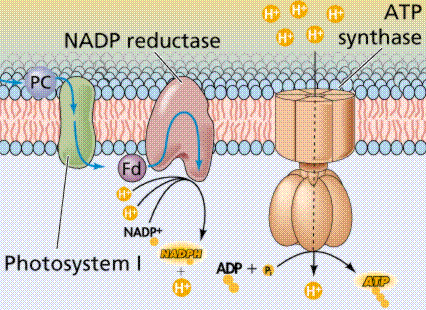
The basic reaction of photosynthesis is:
CO2 + H2O + light energy ---> (CH2O)n + O2
Light energy entering the plant splits the water into hydrogen and oxygen:
H2O + light energy ---> 1/2 O2 + 2H+ + 2 electrons
These electrons travel through the membrane much like the electrons in , oxidative phosphorylation using their energy to pump protons through the membrane. The proton gradient thus established can be used to synthesize ATP.
More importantly, that same electron reduces NADP+ to NADPH. This molecule plays the same role in synthesis as does NAD+ in the respiratory pathway, as a carrier of reductive power. This store of power serves to reduce carbon dioxide to the more complex carbon structure of glucose, the building block of life.

The reactions leading to the production of ATP and reduction of NADP+ are called the light reactions because they are initiated by the splitting of water by light energy. The reduction of carbon dioxide to glucose, using the NADPH produced by the light reactions, is governed by the dark reactions .
All plants and algae remove CO2 from the environment and reduce it to carbohydrate by the Calvin cycle. The process is a sequence of biochemical reactions that reduce carbon and rearrange bonds to produce carbohydrate from CO2 molecules. The first step is the addition of CO2 to a five-carbon compound (ribulose1,5-bisphosphate). The six-carbon compound is split, giving two molecules of a three-carbon compound (3phosphoglycerate). This key reaction is catalyzed by Rubisco, a large water soluble protein complex. The 3-dimensional structure has been determined by X-ray analysis for Rubisco. The carboxylation reaction is energetically downhill. The main energy input in the Calvin cycle is the phosphorylation by ATP and subsequent reduction by NADPH of the initial three-carbon compound forming a three-carbon sugar, triosephosphate. Some of the triosephosphate is exported from the chloroplast and provides the building block for synthesizing more complex molecules. In a process known as regeneration, the Calvin cycycle uses some of the triosephosphate molecules to synthesize the energy rich ribulose 1,5-bisphosphate needed for the initial carboxylation reaction. This reaction requires the input of energy in the form of one ATP. Overall, thirteen enzymes are required to catalyze the reactions in the Calvin cycle. The energy conversion efficiency of the Calvin cycle is approximately 90%. The reactions do not involve energy transduction, but rather the rearrangement of chemical energy. Each molecule of CO2 reduced to a sugar [CH2O]n requires 2 molecules of NADPH and 3 molecules of ATP.

The empirical equation representing the net reaction of photosynthesis for oxygen evolving organisms is :
CO2 + 2H2O + Light Energy ______> [CH2O] + O2 + H2O,
where [CH2O] represents a carbohydrate (e.g., glucose, a six-carbon sugar). The synthesis of carbohydrate from carbon and water requires a large input of light energy. The standard free energy for the reduction of one mole of CO2 to the level of glucose is +478 kJ/mol. Because glucose, a six carbon sugar, is often an intermediate product of photosynthesis, the net equation of photosynthesis is frequently written as :
6CO2 + 12H2O + Light Energy _____> C6H12O6 + 6O2 + 6H2O.
The standard free energy for the synthesis of glucose is +2,870 kJ/mol.
The biochemical conversion of CO2 to carbohydrate is a reduction reaction that involves the rearrangement of covalent bonds between carbon, hydrogen and oxygen. The energy for the reduction of carbon is provided by energy rich molecules that are produced by the light driven electron transfer reactions. Carbon reduction can occur in the dark and involves a series of biochemical reactions.
Most of the proteins required for the conversion of light energy and electron transfer reactions of photosynthesis are located in membranes
A key element in photosynthetic energy conversion is electron transfer within and between protein complexes and simple organic molecules. The electron transfer reactions are rapid (as fast as a few picoseconds) and highly specific.
BACTERIAL PHOTOSYNTHESIS
http://www.life.uiuc.edu/micro/advisor/mcbio200/oct4.html
INTRO TO PHOTOSYSNTHESIS
http://photoscience.la.asu.edu/photosyn/education/photointro.html
My Favorite Links
Back to Home Page
Carbohydrates - Overview
Metabolism
Carbohydrate Function
Food for Thought...